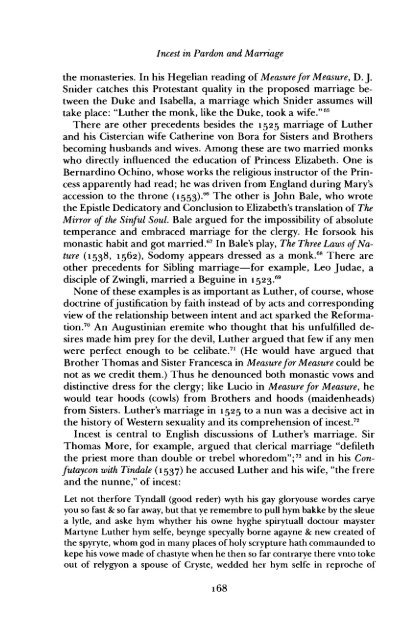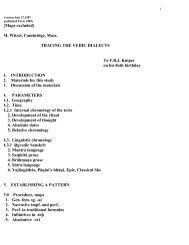Incest in Pardon and Marriage - People Fas Harvard
Incest in Pardon and Marriage - People Fas Harvard
Incest in Pardon and Marriage - People Fas Harvard
Create successful ePaper yourself
Turn your PDF publications into a flip-book with our unique Google optimized e-Paper software.
<strong>Incest</strong> <strong>in</strong> <strong>Pardon</strong> <strong>and</strong> <strong>Marriage</strong><br />
the monasteries. In his Hegelian read<strong>in</strong>g of Measure for Measure, D. J.<br />
Snider catches this Protestant quality <strong>in</strong> the proposed marriage between<br />
the Duke <strong>and</strong> Isabella, a marriage which Snider assumes will<br />
take place: "Luther the monk, like the Duke, took a wife."65<br />
There are other precedents besides the 1525 marriage of Luther<br />
<strong>and</strong> his Cistercian wife Cather<strong>in</strong>e von Bora for Sisters <strong>and</strong> Brothers<br />
becom<strong>in</strong>g husb<strong>and</strong>s <strong>and</strong> wives. Among these are two married monks<br />
who directly <strong>in</strong>fluenced the education of Pr<strong>in</strong>cess Elizabeth. One is<br />
Bernard<strong>in</strong>o Och<strong>in</strong>o, whose works the religious <strong>in</strong>structor of the Pr<strong>in</strong>cess<br />
apparently had read; he was driven from Engl<strong>and</strong> dur<strong>in</strong>g Mary's<br />
accession to the throne (1553).~~ The other is John Bale, who wrote<br />
the Epistle Dedicatory <strong>and</strong> Conclusion to Elizabeth's translation of The<br />
Mirror of the S<strong>in</strong>ful Soul. Bale argued for the impossibility of absolute<br />
temperance <strong>and</strong> embraced marriage for the clergy. He forsook his<br />
monastic habit <strong>and</strong> got married.67 In Bale's play, The Three Laws of Nuture<br />
(1538, 1562), Sodomy appears dressed as a monk.68 There are<br />
other precedents for Sibl<strong>in</strong>g marriage-for example, Leo Judae, a<br />
disciple of Zw<strong>in</strong>gli, married a Begu<strong>in</strong>e <strong>in</strong> 1523.~'<br />
None of these examples is as important as Luther, of course, whose<br />
doctr<strong>in</strong>e of justification by faith <strong>in</strong>stead of by acts <strong>and</strong> correspond<strong>in</strong>g<br />
view of the relationship between <strong>in</strong>tent <strong>and</strong> act sparked the Reformati~n.~'<br />
An August<strong>in</strong>ian eremite who thought that his unfulfilled desires<br />
made him prey for the devil, Luther argued that few if any men<br />
were perfect enough to be ~elibate.~' (He would have argued that<br />
Brother Thomas <strong>and</strong> Sister Francesca <strong>in</strong> Measure for Measure could be<br />
not as we credit them.) Thus he denounced both monastic vows <strong>and</strong><br />
dist<strong>in</strong>ctive dress for the clergy; like Lucio <strong>in</strong> Measure for Measure, he<br />
would tear hoods (cowls) from Brothers <strong>and</strong> hoods (maidenheads)<br />
from Sisters. Luther's marriage <strong>in</strong> 1525 to a nun was a decisive act <strong>in</strong><br />
the history of Western sexuality <strong>and</strong> its comprehension of <strong>in</strong>cest.72<br />
<strong>Incest</strong> is central to English discussions of Luther's marriage. Sir<br />
Thomas More, for example, argued that clerical marriage "defileth<br />
the priest more than double or trebel wh~redom";~~ <strong>and</strong> <strong>in</strong> his Confutaycon<br />
with T<strong>in</strong>dale (1537) he accused Luther <strong>and</strong> his wife, "the frere<br />
<strong>and</strong> the nunne," of <strong>in</strong>cest:<br />
Let not therfore Tyndall (good reder) wyth his gay gloryouse wordes carye<br />
you so fast & so far away, but that ye remembre to pull hym bakke by the sleue<br />
a lytle, <strong>and</strong> aske hym whyther his owne hyghe spirytuall doctour mayster<br />
Martyne Luther hym selfe, beynge specyally borne agayne & new created of<br />
the spyryte, whom god <strong>in</strong> many places of holy scrypture hath commaunded to<br />
kepe his vowe made of chastyte when he then so far contrarye there vnto toke<br />
out of relygyon a spouse of Cryste, wedded her hym selfe <strong>in</strong> reproche of
















